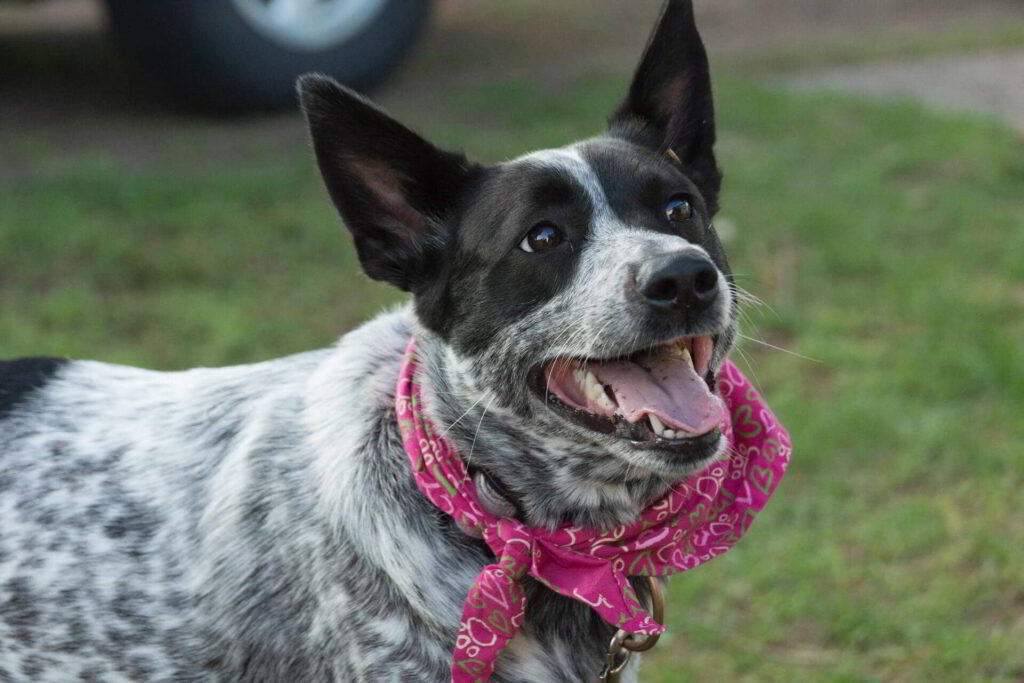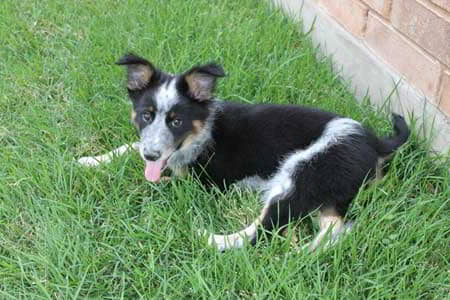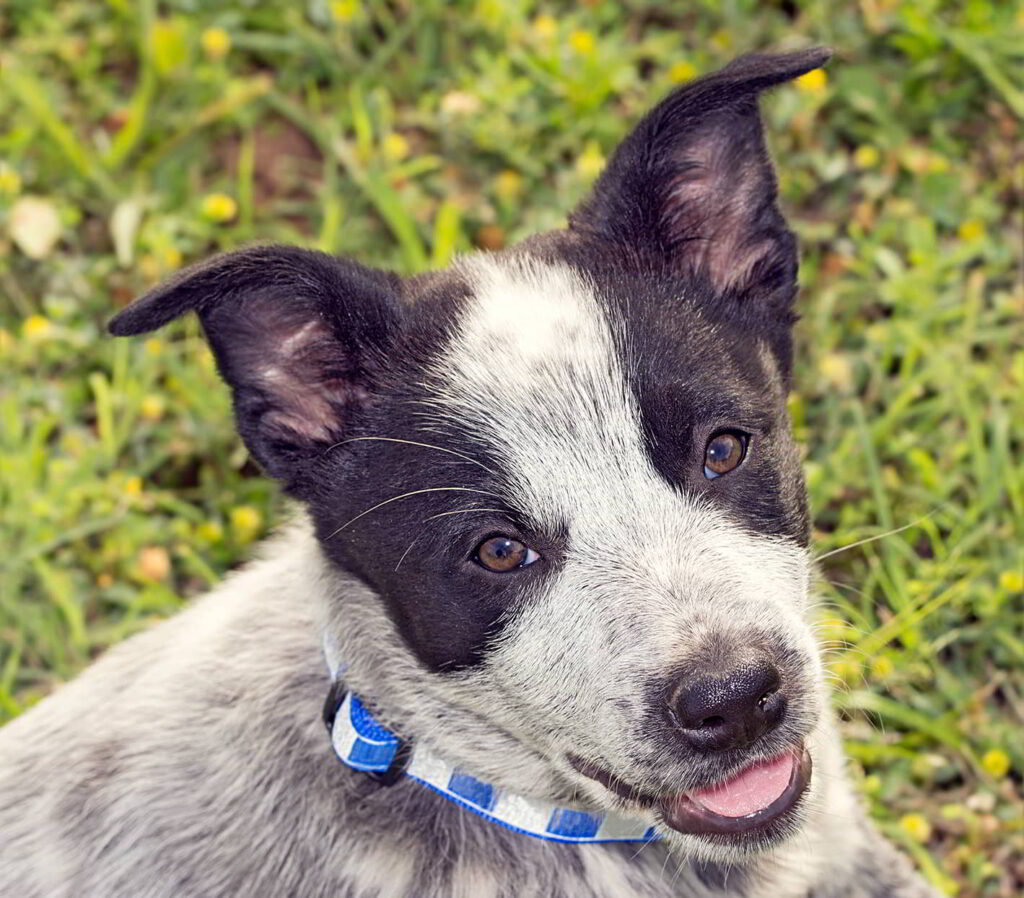Characteristics, History, Care Tips, and Helpful Information for Pet Owners
A mixed-breed dog, the Texas Heeler is an energetic and intelligent working breed. These dogs are a mix between the Australian shepherd and Australian cattle dog, and thus inherited qualities from both parents. They are known for their distinctive blue coats.
Named for the state where they’re most likely to be found, the breed earned its “Heeler” nickname from the Australian cattle dog, because they are often referred to as the Queensland heeler or blue heeler.
These dogs are happiest when they have a job to do, which is why they excel in games and canine sports. They also make a loyal and devoted family companion.

| Breed Overview GROUP: Working HEIGHT: 17-22 Inches WEIGHT: 25-50 Pounds COAT AND COLOR: Short To Medium-Length Coat, Smooth And Soft Fur; Colors Include Black, Blue Merle, Or Blue Ticked With Possibility For White Or Tan Trim On Feet And Legs LIFE EXPECTANCY: 12-15 Years |
Characteristics of the Texas Heeler Dog
| Affection Level | High |
| Friendliness | Moderate |
| Kid-Friendly | Moderate |
| Pet-Friendly | Low |
| Exercise Needs | High |
| Playfulness | High |
| Energy Level | High |
| Trainability | High |
| Intelligence | High |
| Tendency To Bark | Moderate |
| Amount Of Shedding | Moderate |
History of the Texas Heeler
The Texas heeler is a “designer dog” created by breeding two purebreds. In May of 1970, Lucy Guynes registered the Texas Heeler with the Animal Research Foundation, and the breed’s popularity quickly grew as a working dog for farms and ranches in Texas.
But the story of this breed’s origins are still somewhat unique when compared to many other designer breeds. To truly understand the Texas Heeler, you’d have to take a look at the characteristics of both the Australian cattle dog and the Australian shepherd dog. Though they are independent-minded dogs, they also like to be with their owners as much as possible.
In the 1800s, Australian settlers on large ranches bred the Australian cattle dog as a hardy working dog that could help herd cattle; they needed a breed that could tolerate the often challenging climate in Australia. Dogs that had previously been imported from England weren’t proving to be able to withstand the challenging ranch life.
Ranchers began breeding English dogs with the native Dingo of Australia, and most of these canines ended up with a distinctive blue-colored coat. These dogs were often called blue heelers as the glowing blue-haired variety became highly in demand. In 1893, Robert Kaleski began breeding blue heelers, and these dogs were accepted into the American Kennel Club in 1980.
Fast forward to today, and the Australian Cattle Dog is still a breed that requires a great deal of both mental and physical activity and stimulation-if left to their own devices for too long, they tend to get bored and can even become destructive and disobedient. They are still often used as working dogs but they are also popular family dogs. The breed is both territorial and protective, and somewhat suspicious around strangers. However, also, they are loving and loyal with their families and tend to form strong bonds. Because there isn’t a great deal of information on the exact origins of the Texas heeler, an exploration of the history of its parent breeds can help understand this lovable companion and working dog.
Likewise, the Australian Shepherd Dog is also a breed that was created to herd livestock on farms and ranches. Interestingly enough they are not actually from Australia; instead, these are American born purebred dogs that earned their name due to the fact that many people worked on ranches and likely used Australian dogs (such a collies) in the breeding of the Australian Shepherd.
The Australian Shepherd was bred in the 19th century when breeders wanted to create a hard-working, intelligent, and adaptable dog that could have herding abilities. Westerns and cowboys shows and rodeos helped popularize the breed, although it was not recognized by the AKC until 1993.
The Australian Shepherd is still an energetic and intelligent dog-they are usually both protective and dominant, so early socialization and proper training is a must. Like the Australian Cattle Dog, the breed is both fiercely loyal and a wonderful family pet, but wary of strangers. Though they are very affectionate with their families, they can also be very protective and suspicious of strangers. However, these active dogs will be happiest where there’s plenty of room to run and explore, so they’re best suited to anyone who lives on a farm (or has a very big backyard). They will do just fine in city-like settings as well, so long as they get plenty of playtimes and ample exercise.
Because they’re bred from two very active herding breeds, these dogs will require lots of daily exercises. As a working dog, they also prefer having a job to do and are highly task-oriented. They make excellent running and cycling companions, but they will thrive with a variety of activities that condition them physically and stimulate them mentally, like hide-and-seek or fetch, or canine sports.
A highly intelligent breed, the Texas heeler is easily trainable and also likes to make use of his natural herding instincts.

Texas Heeler Care
Texas Heelers are considered to be great family pets. As a result, they’re popular watch dogs (although they often won’t bark unless a stranger is actually spotted). Though they can be great with kids, this a breed that can tend to nip or herd kids from time to time, and they are generally not recommended for homes that already contain other pets.
Though they have short- to medium-length coats, they are thick and double-layered-and tend to shed moderately most of the time. When they blow their undercoats in the spring shedding season (and sometimes even in the fall), the shedding can become heavier. You’ll want to brush out your Texas heeler’s coat at least once or twice weekly with either a bristle or pin brush to help keep their coats as healthy as possible and minimize shedding.
Common Health Problems
Though they are generally healthy, Texas heelers can develop hip and/or elbow dysplasia (a common condition in larger dogs), as well as a condition known as distichiasis. This uncommon condition occurs when an eyelash or eyelashes grow on the inside of the eyelid.
Another potential health issue associated with Blue Heelers is progressive retinal atrophy, a series of incurable conditions that can eventually cause blindness.
Diet and Nutrition
Texas heelers can be prone to weight gain, so ensure that your dog is receiving a biologically appropriate food containing both protein and healthy fats. You will also want to look for formulas with ground bone and vegetables that contain the vitamins and minerals that are essential for this breed’s optimum health and performance.
Pros
- Great family pet
- Easily trainable
- Hard-working
- Very intelligent
Cons
- Require lots of daily exercise and mental stimulation
- Can be wary of strangers
- Can get destructive if left alone too long
- Strong herding instincts

Where to Adopt or Buy a Texas Heeler
The Texas Heeler technically falls under the category of a “designer breed,” which means you’ll likely have to work with a breeder in order to take one of these dogs home. But just like any other mixed breed dog, they can sometimes end up in shelters as well as breed-specific rescues, such as the Texas Cattle Dog Rescue.
More Dog Breeds and Further Research
When determining if the Texas heeler is the right dog for your family, be sure to research all aspects of the breed and consult other Texas heeler dog owners as well as breeders and rescue groups to learn more. In the meantime, you may also check out these other dog breeds:
- Blue Lacy
- Kerry Blue Terrier
- Lancashire Heeler
There’s a wide array of dog breeds out there. With a little research (and plenty of patience), you can find the right match for your family.
